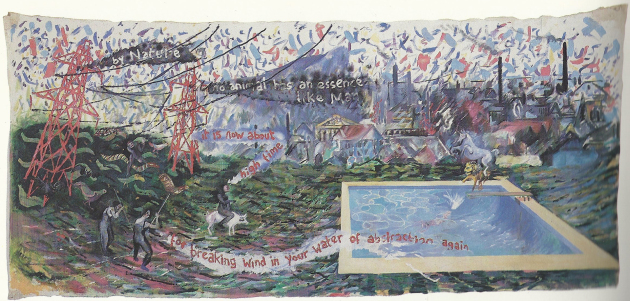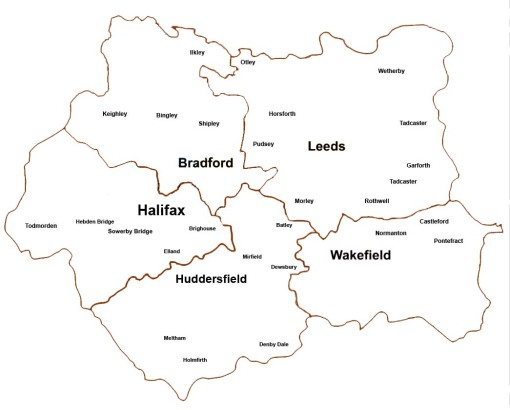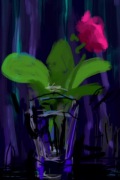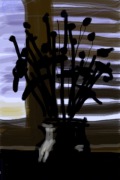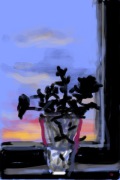
Introduction by Mike Hughes: MODERN AND POST MODERN ARTISTS IN WEST YORKSHIRE
I have for some years owned a book called a “Short Dictionary of the Artists of Yorkshire”. It was published in 1976 by Harry Turnbull who owned the Snape Gallery in Bedale. Turnbull limited his attention to those artists born before 1921. So there are only a few who make it into both directories: William Rothenstein, Jacob Kramer, Matthew Smith, Henry Moore, Barbara Hepworth, Philip Naviasky spring immediately to mind. But there are not really very many artists of note that predate Rothenstein in Turnbull’s short Dictionary. I can only think of the Leeds artist Atkinson Grimshaw. But with the birth date limitation he had placed on himself, Turnbull could not have created a longer dictionary than he did.
Something happened around the beginning of the twentieth century that made this particular part of the county an important international hub of modern art. That hub at iwas the three cities and two towns and their associated townships and settlements which make up West Yorkshire, and whose town halls would fit in a circle with a radius of less than 10 miles. While Turnbull’s slim volume is a delightful tribute to competence and artistic conservatism, this dictionary of artists isn’t that. You could use his volume as a realistic collector's guide, and expect to acquire pieces by most of the artists featured. But you would need to be fantastically wealthy to acquire even fairly modest pieces by a reasonable selection of those on this list.
Since the 1930s a surprising number of some of the most important artists in the world, not merely from England, Great Britain or the UK, have come from West Yorkshire. Before the te second war that would have been, Hepworth and Moore. But since the war it would include Heron, Hockney, Hirst and Goldsworthy. In fact the current membership of the Royal Academy includes Hockney, Norman Ackroyd, Sonia Lawson, Tony Bevan, David Tindle and until earlier in 2014, Ralph Brown. The Royal Academician Hughie O’Donoghue learnt his trade at Trinity and All Saints College, now Trinity University, in Horsforth. Alan Davie another RA who died in 2014 cemented his reputation with a Gregory Fellowship at Leeds University. These fellowships were the brainchild of Herbert Read, a Yorkshireman and early graduate of Leeds University who went on to be the most wide ranging and influential critic and theorist of the 20th century, exerting the same sort of influence on that century that Ruskin and Berenson had in the nineteenth century.
What ignited visual art revolution in West Yorkshire?
Having considered and talked to some of the artists who have become significant in the the second half of the century I have come to to the view that there was not a single spark, but a number of sparks, which turned West Yorkshire into this unlikely powerhouse of fine art.
The municipal art education which had been initiated in the middle of the 19th century to feed the textile and engineering industries had come of age. Right up until the 1960s bright and artisticcally gifted pupils received a first class technical art education from their early teens until they left school, well after the statutory school leaving age.
Private education for a growing, and extraordinarily aspirational, bourgeoisie. Combined with entrepreneurial internaional immigration to the area from the mid nineteenth century, this had created an small, but wealthy and cosmopolitan elite that understood and valued modern art. By the twentieth century they were taking centre stage in municipal life. The creation of Leeds University, the first West Yorkshire university in the first decade of the century only reinforced this. The new university’s vice chancellor, Michael Sadler, was a major collector and patron of the arts and a driving force behind Leeds Arts Club. He was one of the first to own and show Kandinsky’s work in the UK, at his home in Headingley. During his time in the city the Leeds City Gallery stepped out from the philistine, cautious and conservative shadow of municipal Liberalism with the appointment of Frank Rutter, modernist art critic of the Sunday Times, as its director. In Bradford, William Rothenstein an important modernist artist had already had some influence, and his son would go on to direct Leeds and Sheffield Art Galleries before becoming the director of the Tate between 1938 and 1964.
And all this was happening just at the same time that the white heat of mechanical technology, which was not only driving middle class social mobility but also the emeriging radical and progressive socialism of the workers in the local factories in the urban West Yorkshire towns were the Labour Party was born. Technology, urbanism and social radicalism had become a legitimate, or rather obligatory, contemporary artistic subject. It was this lively politcal, social and artistic environment into which Henry Moore and Barbara Hepworth stepped in to Art School in Leeds in 1919 and 1920 respectively.
If Hepworth and Moore were to become the major international stars of modern art in the middle third of the century, that baton would then pass to the likes of Patrick Heron, who though he had left Leeds at quite a young age retained a close connection through his father Tom, who had been an important figure in the Arts Club and retained his West Yorkshire connections though living in the west country.
David Hockney was the next artist to emerge as a major international figure in the twentieth century art world. But he wasn’t the only artist from Bradford to have an influence on Pop Art and the swinging sixties. In fact while Hockney and Peter Blake may have been a high profile part of the swinging sixties their art, they did not have the same the same sort of impact on design that was associated with it. That was more to do with the flat bright colours and fairground techniques of a design agency called BEV, run by Doug Binder, Dudley Edwards and David Vaughan also from Bradford Art School. The extravagant psychedelic portrayal of pop and rock stars that was associated with the sixties and later with prog rock was not the creation of Blake whose portraiture was far less extravagant. It was the creation of Hockney’s and Binder’s contemporary at Bradford, John Oxtoby. Albert Hunt at Bradford Art School was to one of the leading proponent of happenings and performance art.
That might have been enough influence for a small area, far from the art markets of an international capital to exert on a century's art. But the next generation produced another wave of seriously internationally important artists in Damien Hirst, Andy Goldsworthy, Webster and Noble, and Marcus Harvey. But that should not be quite so surprising. Through the fifites and and sixites Herbert Read through his writing and conection with Leeds University, and Harry Thubron at the Art School in Leeds were changing art education for ever, and it was therfore bound to have an impact in West Yorkshire.
Read introduced the Gregory Fellowship at the University and Thubron promoted a radical and imaginative approach to art education, and was one of the most influential champions for the creation of multi disciplinary Polytechnics. Major artists were now routinely part of an art education in West Yorkshire and there were important and often radically anarchic faculty members to fire the imagination, Anthony Earnshaw and Jeff Nuttall amongst them. Terry Atkinson, of Art and Language, would provide a slightly more disciplined and cerebral perspective into the mix. When John Hyatt gradated from the University, he soon found himself teaching alongside these, as well as fronting the post punk band The Three Johns. With a recent Henry Moore Fellowship under his belt, when the second five yearly British Art Show opened in 1984, Hyatt’s work “Art Wars” was chosen for the catalogue cover.
"Art Wars" was an unmistakeable post modern work, inspired by Patrick Heron’s writing about American artistic imperialism. Painted using household paint, on a massive piece of canvas nailed to the wall of his room in Headingley, the Leeds suburb where Sadler lived and Heron had been born), it was crammed with referential imagery: a unicorn and lion jump into a Hockney pool, pylons striding across a landscape reminding us that the Three Johns were criss-crossing the country playing benefits for the striking miners (although "Art Wars" was completed before that strike). Hirst had Just finished his foundation course at Jacob Kramer, Harvey was at Goldsmiths' College.
Last year Leeds Art Gallery acquired Art Wars for its collection. In 2015 the British Art Show 8 opens in Leeds.
So?….
There is no single thread that runs through this story, the artists are different and because they are significant they are distinctive. It is the place, and the history that binds them like a baton binds relay racers. There are themes that recur: mischief, abstraction, figuration and a solid surreal/absurdist tradition. But I also think there is another critical factor. It was imaginative, flexible, excellent art education in turned West Yorkshire into the nexus it has become for modern art. It is remarkable how interested all these artists are not only in creating memorable and unique imagery but in investigating, teaching or telling others about what they and how and why they do it; in understanding the techniques of making art and in understanding how art works. This is one of the things that would link such different artists as Atkinson, Hirst and Hockney together. Given the importance of the area in the the visual arts, and for the matter in literature, it is staggering that the politicians of Leeds and/or Bradford and/or West Yorkshire have never demonstrated the self awareness and self estem required to secure the title European Capital of Culture.
Contemporary Artists in the area
This is a dictionary rather than a directory and it therefore isn’t a full list of all the artists for whom West Yorkshire had played a significant role in their careers, just an indication I hope that I am not completely off the rails in the making the claim for West Yorkshire’s international significance in the development of the last and the current century’s art. My criteria for inclusion include major reputation, including commissions and the valuations of work, substantial teaching reputation and roles and influence, and substantial public exhibitions, and in in a complicated way consistency and staying power.
I have tried to be impartial in the way I have exercised my prejudices and there is only one artist of any national prominence that in all honesty could not bring myself to include. If I have missed others is it is purely from ignorance or oversight so let me know. This is just a work in progresst.
The other thing I need to say is that this is not intended to be a directory of all practicing artists currently working in this small area. One of the consequences of the vital recent history, and an internationally important adult education system, is that any moment of time there is I guess, in excess of 3000 fine artists in training in the area. Any directory of active artists would be very different to what I have set out to do here. I know, for example, that I have not included all current and recent teaching staff at the various colleges and Universities. That is not so much an oversight as it is a reflection of the poverty of the Colleges’ and Universities’ online histories, and the fact that I have not been able to find any good secondary source, article or book, about the history of art education in the area.
So this is not the place to try to find undiscovered or rising stars, there are some underrated artists in here though that you would do well to look up. Clink the link below to find a list of useful links to practicing artists in the region:
Useful Links for contemporary practicving artists in the region
Art Schools and Public Galleries
West Yorkshire - a geographical footnote:
Yorkshire is large county and while the administrative unit of the english county was normally a “hundred” Yorkshire was divided into three three separate divisions of Hundreds. A north, East and West Riding.
The west riding was the main industrial areas including the cities of Leeds, Wakefield, Bradford. Doncaster and Sheffield and the surrounding towns. It was large area, largely industrialised but with a pretty distinct difference between the north and the south of the area.
West Yorkshire was created by the local Government act in 1974 and was smaller recognising the fdifferences between the between the north and sound of the old riding. What was created was urban conurbation centred on three cities:
- Leeds and its associated town ships: Morley, Pudsey, Horsforth, Yeadon, Guisley, Tadcaster, Garforth
- Bradford and its associated town ships: Shipley, Ilkley, Keighley, Cleckheaton
- Wakefield and its associated town ships: Pontefract, Castleford, Normanton, Rothwell, Hemsworth
and two large towns :
- Halifax and its associated townships: Sowerby Bridge, Todmorden, Elland, Brighouse, Hebden Bridge
- Huddersfield and its associated town ships: Saddleworth, Dewsbury, Batley, Bingley, Mirfield, Metlham, Holmfirth.
Today West Yorkshire has a population of 2.2m making it the fourth largest county.
It is this conurbation that is covered in this dictionary.

